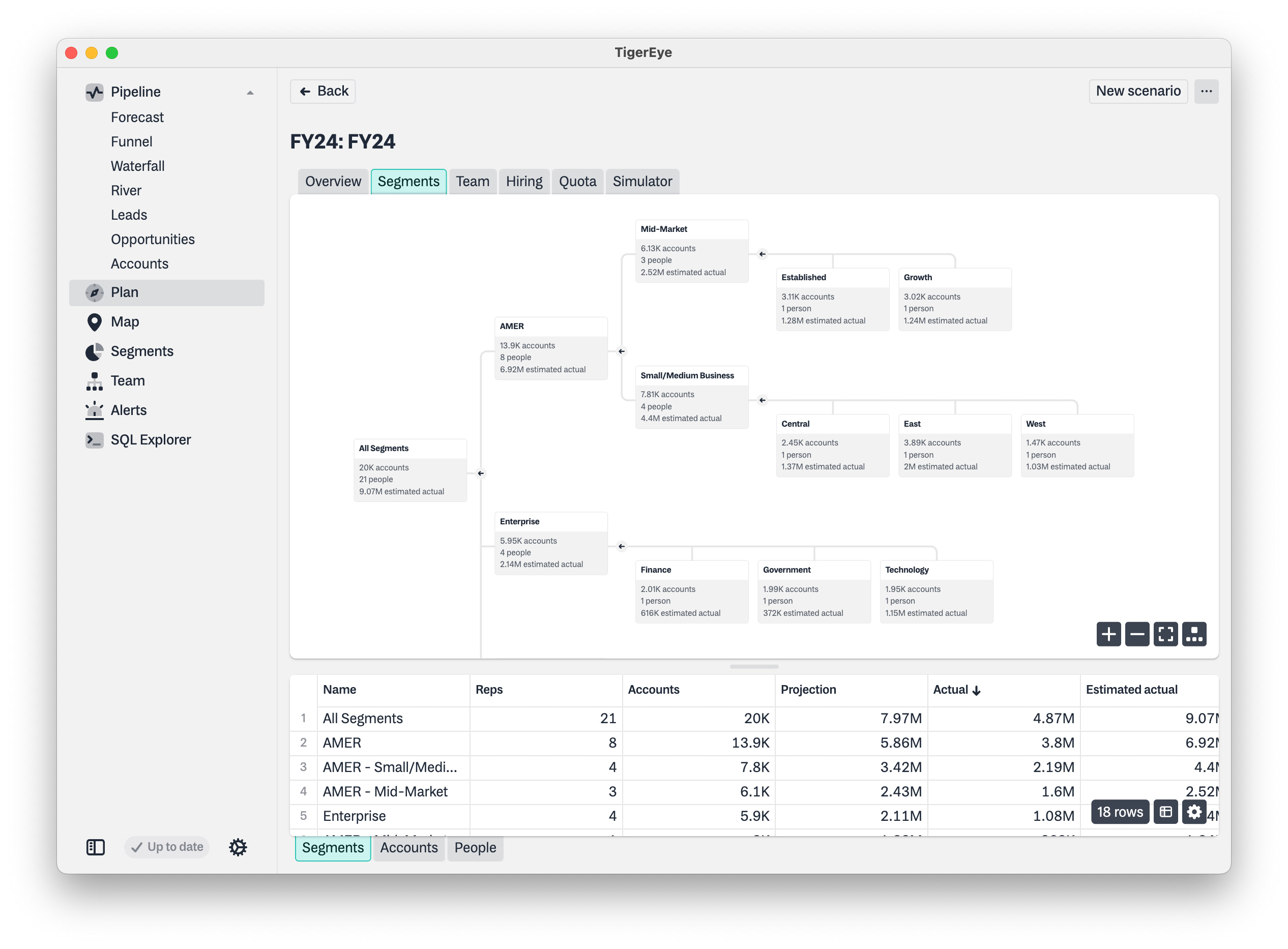
BACK TO BLOG
The Power of Parametric Account Segmentation
Learn about account segmentation in TigerEye
April 18, 2024

Sales segmentation is how go-to-market teams group prospects and accounts and organize the sales team. Getting account segmentation right is key to unlocking growth for B2B products and services.
Account attributes are used to group the full market into smaller segments based on location, firm type, size, etc. Segmentation drives go-to-market alignment: Sales team organization. Marketing campaign prioritization. Finance and GTM reporting.
TigerEye makes account segmentation faster and smarter. We’ve built a new way to iterate and experiment that is helping teams find and deploy the right model for growth.
The Love / Hate Assignment
Recently, a sales ops team I worked with got one of those love / hate assignments. Our account segmentation model just wasn’t working and it was time to refresh.
Projects like this are a way for Revenue Operations to help translate strategy into action. The best sales ops leaders are fastidious and detail oriented. They love to organize.
And what is a better organization project than improving the segmentation model for the team? Lots of research. A chance to clean up some of the mess that complicates reporting.
The best sales ops leaders also know that sales segmentation is never as simple as it should be. There are endless factors to consider when updating segments: coverage continuity, team balancing, emotional attachments. And worst of all, no good tools to help make any of this easier.
To make things worse, most Ops teams are still building segments with spreadsheets and Tableau.
While the project is exciting, creating each variation requires too much time. This leaves no time for experimentation or “what if” scenario design.

The Challenge
Sales segmentation shouldn’t be so hard. In fact, I think it should be fun, serious work. Like a challenging, high-stakes puzzle — think Elden Ring for operations. It should be the kind of project around which teams rally, aiming to grow the business for themselves and everyone involved.
Each sales rep generates their income from the accounts they manage. Segmentation is very personal for them. Reps want their accounts to be happy and to continue earning from the work they’ve put in. When sales reps lose accounts, they don’t buy into the process and the new segmentation model is dealt a serious blow before it has a chance to help.
Software won’t make losing an account feel good, but it should offer data to counter emotion. It should encourage curiosity and exploration.
This is what we are delivering with parametric segmentation in TigerEye. TigerEye builds the actual account lists in seconds. It is easy to bring sales managers and reps along at every step - how the change will raise all boats. Seeing how proposed changes will play out early leads to fast feedback cycles and low-cost iteration. A better way to organize accounts to help you serve customers better and grow across the business.
Let me begin by quickly explaining what we mean by parametric segmentation.

Parametric Segmentation
Accounts are bucketed in a few common ways: location, business type, current spend, etc. Each of these attributes is what we consider a ‘parameter’ and TigerEye’s account segmentation tools simply create rules to categorize accounts accordingly.
Rule Hierarchy
For rules to be effective, you will create several layers of hierarchy to the segmentation model. TigerEye segments have an explicit parent/child hierarchy. The rules on parent segments are applied before the children, so each rule can be very simple. Here’s an example:
EMEA (account.region = "EMEA")
Enterprise (account.numberOfEmployees >= 1000)
Mid-market (account.numberOfEmployees >= 500)
SMB (account.numberOfEmployees = > 0)
APAC (account.region = "APAC")
AMER (account.region = "AMER")
The EMEA segment rule narrows down the list of accounts available to the child rules. Each child's rule is very simple because it only applies to the accounts passed on from the parent. Using simple ordered rules helps everybody understand how the engine works, and reduces the risk of errors.
But What Parameters?
To get the most out of parametric segmentation, build the rules from attributes that are relevant to your business. Just about any attribute in your CRM can be used as a segmentation parameter. Parameters generally fall into one of two buckets:
External Characteristics - Attribute fields on your account object contain segment-able data. This generally includes some of the parameters we’ve used above including firm size and location, but could also include market segment, industry, revenue or more.
Internal Characteristics - Many companies use aspects of their current relationship with their prospects/customers to create segments. If you have a separate Customer Success Management (CSM) team responsible for renewals, you might create a rule that separates paying customers from prospects. Alternatively, you might group accounts by their current spend level with your business.
Levels of Segmentation
There can be a temptation to overcomplicate segmentation when it is so simple to define these rules. Just remember that the goal is always to help the business understand and organize itself better, and part of that understanding comes from choosing a model that can be easily understood by the entire sales force. Basically, keep it as simple as possible, and remember that every level you add will be harder from others to understand.
Segmentation vs. Reporting
There can be a temptation to conflate sales segmentation with reporting. Reporting is critical to every business's growth, but should be viewed as a separate topic.
The goal of segmentation is to structure all accounts by a single, universal hierarchy that the team can organize around.
The goal of reporting is to understand performance by any number of dimensions for any period.
As long as data is well structured, it will feed a well tidy segment structure while also making itself available for sophisticated reporting queries.
Speaking of well structured data…
Real talk: My CRM is a mess
This is a no judgment zone. Keeping CRM data up to date is hard even when the process is well organized. If there is no tangible benefit felt by the team to contribute data improvements it will always be behind. Helping the team understand the benefits of clean data is job number one.
With parametric segmentation, teams know that clean data means account assignments are accurate, so they want to make sure their accounts are well defined. And, of course, there are more options for data enrichment than have ever been available before, so it doesn’t need to be a manual process.
We’ve found that TigerEye helps teams really understand where they have data gaps and helps prioritize addressing them. Each level of the segment tree includes an ‘Unassigned’ bucket. These accounts matched the rules of the parents, but not any of the child nodes. For example, if you have industry segments, records where ‘Industry’ is blank or not identified in another rule would show up here. This helps to validate that rules are working as intended and makes the scale of potential missing data clear at each level of the tree.
Real Time KPIs
Every time you adjust a segment in TigerEye the app updates key metrics instantly. This means you’ll see the number of accounts and estimated revenue right away. But things get really interesting when you aren’t constrained by a single segmentation model.
Segments in the multiverse
Typically segmentation updates are made as part of sales and go-to-market planning. This is the most common case in TigerEye as well. You can create as many plans as you wish and explore different segmentation structures in each one.
The plan simulation is constantly running as you make changes, so segment KPIs in the context of a plan are not just showing where you’re clocking out today, but where you’re likely to end up if you choose this path. 🤯
We can do this because the TigerEye timestream database is learning how your business works through every change in every opportunity. Different sales reps have a unique fingerprint and so do different teams and accounts. Changing the segmentation structure alters this balance and the TigerEye Sim plays out those changes in its prediction of what will happen in each scenario.
Combined with the other aspects of the TigerEye plan (hiring and ramp schedule, performance variables and team assignment), you’ve got a virtual clone of how your business is likely to perform in the future.
Back to the beginning
Coming back to that project we started with. If that Sales Ops team had TigerEye, they would have saved countless hours and tons of heartache. They would have defined new segments in minutes and used some of the saved time to explore alternate paths. TigerEye is collaborative from the ground up. Rather than defining segments in a silo, they would have brought the sales and marketing to the table. Real time feedback would have helped the team make smarter decisions and strengthened the relationship between teams.
Editing segments in TigerEye is so fast, you can carve a new one in less than 30 seconds:
To see parametric segmentation for yourself, watch our recent on-demand webinar or schedule a personalized demo today.

.png)


.png)
.png)

.png)
.png)
%20(1).jpg)